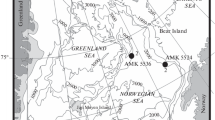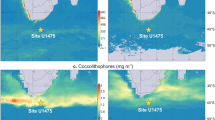Abstract
The benthic and planktonic foraminiferal assemblages and the distribution of coarse grain-size factions were studied in the upper 4.5 m of the Core SO201-2-85KL (57°30.30′ N, 170°24.79′ E, water depth 968 m) retrieved from the Shirshov Ridge. This part of the core covers 7.5 to 50 kyr BP. The glacial period is established to be characterized by low surface water productivity, the wide distribution of sea ice and/or icebergs in this area, and a high oxygen concentration in the bottom layer. Enhanced productivity is inferred from the maximum abundance of planktonic foraminifers at the very beginning of the deglaciation. The late Bølling-Allerød interstadial and the early Holocene were marked by the further two-phase increase in the surface productivity and the weakened ventilation of the bottom water.
Similar content being viewed by others
References
V. S. Arsen’ev, Currents and Water Masses of the Bering Sea (Nauka, Moscow, 1967) [in Russian].
N. V. Bubenshchikova, D. Nürnberg, S. A. Gor- barenko, and L. Lembke-Jene, “Variations of the Oxygen Minimum Zone of the Okhotsk Sea during the Last 50 ka as Indicated by Benthic Foraminiferal and Biogeochemical Data,” Oceanology 50(1), 93–106 (2010).
I. I. Burmistrova, M. P. Chekhovskaya, and N. V. Belyaeva, “Benthic Foraminifers in Eastern Slope of the Bering Seas,” Oceanology 44(5), 734–742 (2004).
S. A. Gorbarenko and E. L. Gol’dberg, “Assessment of Variations of Primary Production in the Sea of Okhotsk, Bering Sea, and Northwestern Pacific over the Last Glaciation Maximum and Holocene,” Dokl. Earth Sci. 405A(9), 1380–1383 (2005).
A. P. Lisitsyn, Current Sedimentation Processes in the Bering Sea (Nauka, Moscow, 1966) [in Russian].
Kh. M. Saidova, Ecology of Foraminifers and Paleogeography of the Far East Seas of USSR and Northwestern Pacific (Akad. Nauk SSSR, Moscow, 1961) [in Russian].
T. A. Khusid, I. A. Basov, S. A. Gorbarenko, and M. P. Chekhovskaya, “Benthic Foraminifers in Upper Quaternary Sediments of the Southern Bering Sea: Distribution and Paleoceanographic Interpretations,” Stratigr. Geol. Correl. 14(5), 538–548 (2006).
M. P. Chekhovskaya, I. A. Basov, A. G. Matul, T. A. Khusid, and S. A. Gorbarenko, “Planktonic Foraminifers in the Southern Bering Sea: Changes in Composition and Productivity during the Late Pleistocene — Holocene,” Stratigr. Geol. Correl. 16(3), 328–342 (2008).
G. R. Bigg, C. D. Clark, and A. L. C. Hughes, “A Last Glacial Ice Sheet on the Pacific Russian Coast and Catastrophic Change Arising from Coupled Ice-Volcanic Interaction,” Earth Planet. Sci. Lett. 265, 559–570 (2008).
B. E. Caissie, J. Brigham-Grette, K. T. Lawrence, et al., “Last Glacial Maximum to Holocene Sea Surface Conditions at Umnak Plateau, Bering Sea, as Inferred from Diatom, Alkenone, and Stable Isotope Records,” Paleoceanography 25, PA1206 (2010). doi 10.10.1029/2008PA001671.
R. Chen, Y. Meng, R. Wang, D. Hua, and J. Xu, “Oceanographic Records of Microorganisms in the Surface Sediments from the Bering and Chukchi Seas,” Asian J. Water, Environ. Pollut. 2(1), 19–26 (2005).
M. S. Cook, L. D. Keigwin, and C. A. Sancetta, “The Deglacial History of Surface and Intermediate Water of the Bering Sea,” Deep-Sea Res., Part II 52, 2163–2173 (2005).
K. F. Darling and C. M. Wade, “The Genetic Diversity of Planktic Foraminifera and the Global Distribution of Ribosomal RNA Genotypes,” Marine Micropaleontology 67, 216–238 (2008).
SO201-KALMAR Leg 2 Cruise Report No. 35, Ed. by W.-C. Dullo, B. Baranov, and C. van den Bogaard (IFM-GEOMAR, Germany, 2009).
H. Gebhardt, M. Sarnthein, P. M. Grootes, et al., “Paleonutrient and Productivity Records from the Subarctic North Pacific for Pleistocene Glacial Terminations I to V,” Paleoceanography 23, PA4212 (2008). doi 10.1029/2007PA001513.
S. A. Gorbarenko, “Stable Isotope and Lithological Evidence of Late-Glacial and Holocene Oceanography of the Northwestern Pacific and Its Marginal Seas,” Quaternary Res. 46, 230–250 (1996).
S. A. Gorbarenko, I. A. Basov, M. P. Chekhovskaya, et al., “Orbital and Millennium Scale Environmental Changes in the Southern Bering Sea during the Last Glacial-Holocene: Geochemical and Paleontological Evidence,” Deep-Sea Res., Part II 52, 2174–2185 (2005).
S. A. Gorbarenko, P. Wang, R. Wang, and X. Cheng, “Orbital and Suborbital Environmental Changes in the Southern Bering Sea during the Last 50 kyr,” Palaeogeogr., Palaeoclimatol., Palaeoecol. 286, 97–106 (2010).
M. Hald, C. Andersson, H. Ebbesen, et al., “Variations in Temperature and Extent of Atlantic Water in the Northern North Atlantic during the Holocene,” Quat. Sci. Rev. 26, 3423–3440 (2007).
J. C. Herguera, T. Herbert, M. Kashgarian, and C. Charles, “Intermediate and Deep Water Mass Distribution in the Pacific during the Last Glacial Maximum Inferred from Oxygen and Carbon Stable Isotopes,” Quat. Sci. Rev. 29, 1228–1245 (2010).
J. Imbrie and N. G. Kipp, “A New Micropaleontological Method for Quantitative Paleoclimatology: Application for a Late Pleistocene Caribbean Core,” in The Late Cenozoic Glacial Ages, Ed. by K. Turikian (Yale Univ. Press, New Haven, 1971), pp. 71–181.
S. L. Jaccard, G. H. Haug, D. M. Sigman, et al., “Glacial/Interglacial Changes in Subarctic North Pacific Stratification,” Science 308, 1003–1006 (2005).
F. J. Jorissen, C. Fontanier, and E. Thomas, “Paleoceanographical Proxies Based on Deep-Sea Benthic Foraminiferal Assemblage Characteristics,” in Proxies in Late Cenozoic Paleoceanography, Part 2: Biological Tracers and Biomarkers, Ed. by C. Hillaire-Marcel and A. de Vernal (Elsevier, Amsterdam, 2007), pp. 263–325.
K. Kaiho, “Benthic Foraminiferal Dissolved-Oxygen Index and Dissolved-Oxygen Levels in the Modern Ocean,” Geology 22, 719–722 (1994).
K. Katsuki and K. Takahashi, “Diatoms as Paleoenvironmental Proxies for Seasonal Productivity, Sea-Ice and Surface Circulation in the Bering Sea during the Late Quaternary,” Deep-Sea Res., Part II 52, 2110–2130 (2005).
S. Kim, B. K. Khim, M. Uchida, et al., “Millennial-Scale Paleoceanographic Events and Implication for the Intermediate-Water Ventilation in the Northern Slope Area of the Bering Sea during the Last 71 Kyrs,” Global and Planetary Change 79, 89–98 (2011).
K. Kohfeld and Z. Chase, “Controls on Deglacial Changes in Biogenic Fluxes in the North Pacific Ocean,” Quat. Sci. Rev. 30, 3350–3363 (2011).
K. E. Kohfeld and R. G. Fairbanks, “Neogloboquadrina pachyderma (Sinistral Coiling) as Paleoceanographic Tracers in Polar Oceans: Evidence from Northeast Water Polynya Plankton Tows, Sediment Traps, and Surface Sediments,” Paleoceanography 11(6), 679–699 (1996).
S. A. Korsun and M. Hald, “Modern Benthic Foraminifera off Novaya Zemlya Tidewater Glaciers, Russian Arctic,” Arct. Alp. Res. 30(1), 61–77 (1998).
V. Luchin, V. Menovshchikov, and V. E. Lavrentiev, “Thermohaline Structure and Water Masses in the Bering Sea,” in Dynamics of the Bering Sea, Ed. by T. R. Loughlin and K. Ohtani (Univ. of Alaska Sea Grant, Fairbanks, 1999), pp. 61–91.
L. Max, J.-R. Riethdorf, R. Tiedemann, et al., “Sea Surface Temperature Variability and Sea-Ice Extend in the Subarctic Northwest Pacific during the Past 15 000 Years,” Paleoceanography 27, PA3213 (2012). doi 10.1029/2012PA002292.
Y. Okazaki, A. Timmermann, L. Menviel, et al., “Deepwater Formation in the North Pacific during the Last Glacial Termination,” Science 329, 200–204 (2010).
J. D. Ortiz, A. C. Mix, and R. W. Collier, “Environmental Control of Living Symbiotic and Asymbiotic Foraminifera of the California Current,” Paleoceanography 10(6), 987–1009 (1995).
J.-R. Riethdorf, L. Max, D. Nürnberg, and R. Tiedemann, “Late Pleistocene to Holocene Changes in Sea Surface Temperature, Marine Productivity and Terrigenous Fluxes in the Western Bering Sea,” in Abstracts of the KALMAR Workshop (Trier, Germany, 2011), pp. 105–107.
G. I. Roden, “Flow and Water Property Structures between the Bering Sea and Fiji in the Summer of 1993,” J. Geophys. Res. 105(C12), 28595–28612 (2000).
B. K. Sen Gupta and M. L. Machain-Castillo, “Benthic Foraminifera in Oxygen-Poor Habitats,” Marine Micropaleontology 20, 83–201 (1993).
A. M. Springer, C. P. McRoy, and M. V. Flint, “The Bering Sea Green Belt: Shelf-Edge Processes and Ecosystem Production,” Fisheries Oceanography 5(3/4), 205–223 (1996).
P. J. Stabeno, J. D. Schumacher, and K. Ohtani, “The Physical Oceanography of the Bering Sea,” in Dynamics of the Bering Sea, Ed. by T. R. Loughlin and K. Ohtani, (Univ. of Alaska Sea Grant, Fairbanks, 1999), pp. 1–21.
R. Stein, Arctic Ocean Sediments: Processes, Proxies, and Paleoenvironment (Elsevier, Amsterdam, 2008).
K. E. K. John, St. and L. A. Krissek, “Regional Patterns of Pleistocene Ice-Rafted Debris Flux in the North Pacific,” Paleoceanography 14, 653–662 (1999).
E. Thomas, E. Booth, M. Maslin, and N. J. Shackleton, “Northeastern Atlantic Benthic Foraminifers during the Last 45 000 Years: Changes in Productivity Seen from the Bottom Up,” Paleoceanography 10, 545–562 (1995).
J. Zhang, R. Woodgate, and R. Moritz, “Sea Ice Response to Atmospheric and Oceanic Forcing in the Bering Sea,” J. Phys. Oceanogr., No. 40, 1729–1747 (2010).
Author information
Authors and Affiliations
Corresponding author
Additional information
Original Russian Text © E.A. Ovsepyan, E.V. Ivanova, L. Max, J.-R. Riethdorf, D. Nürnberg, R. Tiedemann, 2013, published in Okeanologiya, 2013, Vol. 53, No. 2, pp. 237–248.
Rights and permissions
About this article
Cite this article
Ovsepyan, E.A., Ivanova, E.V., Max, L. et al. Late quaternary oceanographic conditions in the Western Bering Sea. Oceanology 53, 211–222 (2013). https://doi.org/10.1134/S0001437013020136
Received:
Accepted:
Published:
Issue Date:
DOI: https://doi.org/10.1134/S0001437013020136




